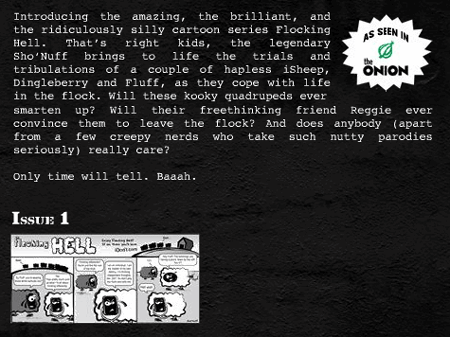There was a time when a micro site designed specifically to be viral absolutely required a “Tell A Friend” link, to facilitate its contagion. Today, especially with a young audience, this rule is frequently broken. I have a couple theories.
The obvious one is the anti-marketing factor. When you’re communicating to a jaded audience that wants to feel like they’re doing something spontaneous, make the pass-along more difficult.
Take the recent viral campaign waged by SanDisk. It’s to promote their latest alternative to the ubiquitous iPod music player. Talk about David versus Goliath. They’ve taken a shot at felling the giant with www.iDont.com, a site that positions the act of listening to a song on anything other than an iPod as the stuff of rebels and iconoclasts.
The campaign includes outdoor and print ads driving folks to the site. The ads appear most notably in the alternative weekly The Onion. This graphic is a screen cap from the site.
Most of the ad units are small, and effectively intriguing and edgy. Little but the web address is on them. This cartoon ad is an exception, in that it gives a few more details about why visiting the site might be rewarding.
And what rich rewards await you? The main one is the promise of feeling like an Apple Mac owner in 1984 (how the tides turn, with the Apple iPod being the status quo of portable listening devices!).
Keeping with a less promotional marketing approach, there is only one link in whole site (as far as I can tell) to the SanDisk site, and that’s a link to a dealer locator tool. It allows you to investigate and perhaps buy “The Alternative” — the Sansa e200 MP3 player.
So: To make the site feel right to the audience, take away a helpful feature.
My other theory is that this audience — those under 30 — are far less likely to find the “Email a Friend” helpful in the first place. This market segment would just as likely pass the link along via instant messaging (IM), in the course of an online conversation, or through a personal message (PM). Less likely, it might show up on a social networking page or a personal blog (as I’ll get to in a moment).
My point is that all of the sharing strategies mentioned above require either the typing of a simple, five-letter domain name, or more likely, the cutting and pasting of that web address. Cake.
A youth wasted on generating content (that the press has creatively dubbed “user-generated”) has taught even the least swift of this target market to pass along something without the aid of an email form. The very use of the form may scream of yesterday’s media.
The big question remains: Will this be passed along? And on a macro level: Can anyone not of this demographic create something compelling enough to want to share? These statistics tell the story. The site has a Google Page Rank of zero, and, although MSN has found over 5,000 links to it, Google and AOL showed zip. Goliath can sleep safely.
